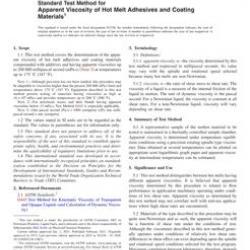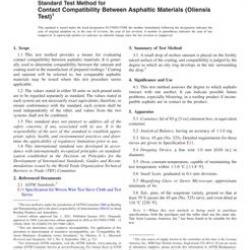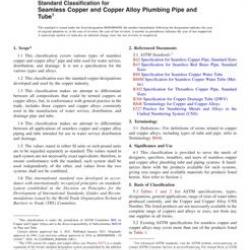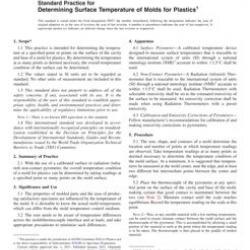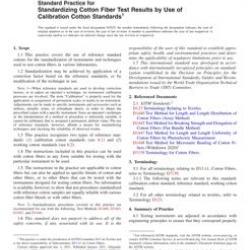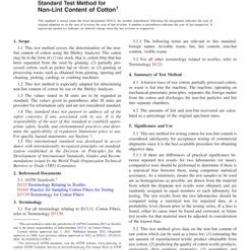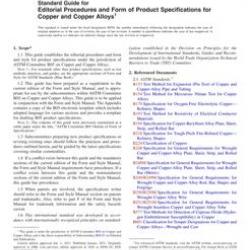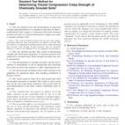No products
ASTM D4814-16ee1
ASTM D4814-16ee1 Standard Specification for Automotive Spark-Ignition Engine Fuel
standard by ASTM International, 11/15/2016
Full Description
1.1This specification covers the establishment of requirements of liquid automotive fuels for ground vehicles equipped with spark-ignition engines.
1.2This specification describes various characteristics of automotive fuels for use over a wide range of operating conditions. It provides for a variation of the volatility and water tolerance of automotive fuel in accordance with seasonal climatic changes at the locality where the fuel is used. For the period May 1 through Sept. 15, the maximum vapor pressure limits issued by the United States (U.S.) Environmental Protection Agency (EPA) are specified for each geographical area except Alaska and Hawaii. Variation of the antiknock index with seasonal climatic changes and altitude is discussed in Appendix X1. This specification neither necessarily includes all types of fuels that are satisfactory for automotive vehicles, nor necessarily excludes fuels that can perform unsatisfactorily under certain operating conditions or in certain equipment. The significance of each of the properties of this specification is shown in Appendix X1.
1.3The spark-ignition engine fuels covered in this specification are gasoline and its blends with oxygenates, such as alcohols and ethers and where gasoline is the primary component by volume in the blend. The concentrations and types of oxygenates are not specifically limited in this specification. The composition of both unleaded and leaded fuel is limited by economic, legal, and technical consideration, but their properties, including volatility, are defined by this specification. In many countries, regulatory authorities having jurisdiction have set laws and regulations that limit the concentration of oxygenates and certain other compounds found in spark-ignition engine fuel. In the United States, oxygenate types and concentrations are limited to those approved under the U.S. Environmental Protection Agency's (EPA) substantially similar rule (see X3.3.1), waivers, and partial waivers including some restrictions on vehicle and equipment use (see X3.3.2). With regard to fuel properties, including volatility, this specification can be more or less restrictive than the EPA rules, regulations, and waivers. Refer to Appendix X3 for discussions of EPA rules relating to fuel volatility, lead and phosphorous contents, sulfur content, benzene content, deposit control additive certification, and use of oxygenates in blends with unleaded gasoline. Contact the EPA for the latest versions of the rules and additional requirements.
1.4This specification does not address the emission characteristics of reformulated spark-ignition engine fuel. Reformulated spark-ignition engine fuel is required in some areas to lower emissions from automotive vehicles, and its characteristics are described in the research report on reformulated spark-ignition engine fuel.2 However, in addition to the legal requirements found in this research report, reformulated spark-ignition engine fuel should meet the performance requirements found in this specification.
1.5This specification represents a description of automotive fuel as of the date of publication. The specification is under continuous review, which can result in revisions based on changes in fuel, automotive requirements, or test methods, or a combination thereof. All users of this specification, therefore, should refer to the latest edition.
Note 1:If there is any doubt as to the latest edition of Specification D4814, contact ASTM International Headquarters.
1.6Tests applicable to gasoline are not necessarily applicable to its blends with oxygenates. Consequently, the type of fuel under consideration must first be identified in order to select applicable tests. Test Method D4815 provides a procedure for determining oxygenate concentration in mass percent. Test Method D4815 also includes procedures for calculating mass oxygen content and oxygenate concentration in volume percent. Appendix X4 provides a procedure for calculating the mass oxygen content of a fuel using measured oxygenate type, oxygenate concentration in volume percent, and measured density or relative density of the fuel.
1.7The following applies to all specified limits in this standard: For purposes of determining conformance with these specifications, an observed value or a calculated value shall be rounded to the nearest unit in the right-most significant digit used in expressing the specification limit, in accordance with the rounding method of Practice E29. For a specification limit expressed as an integer, a trailing zero is significant only if the decimal point is specified. For a specified limit expressed as an integer, and the right-most digit is non-zero, the right-most digit is significant without a decimal point being specified. This convention applies to specified limits in Tables1, 3, and X8.1, and it will not be observed in the remainder of this specification.
1.8The values stated in SI units are the standard, except when other units are specified by U.S. federal regulation. Values given in parentheses are provided for information only.
Note 2:Many of the values shown in Table 1 were originally developed using U.S. customary units and were subsequently soft-converted to SI values. As a result, conversion of the SI values will sometimes differ slightly from the U.S. customary values shown because of round-off. In some cases, U.S. federal regulations specify non-SI units. (A)See 1.7 for determining conformance with specification limits in this table. When using this table to determine the conformance of gasoline volatility, the reader is advised to review other applicable national, state, provincial, or local requirements. (For example, in the U.S. these may include the EPA Substantially Similar rule, California Air Resources Board (CARB), Clean Burning Gasoline (CBG), other state or local and pipeline specifications). See Appendix X3 for a summary of applicable U.S. EPA regulations for spark-ignition engine fuels.(B)Consult EPA for approved test methods for compliance with EPA vapor pressure regulations.(C)At 101.3 kPa pressure (760 mm Hg).(D)Gasolines that may be blended with 1% to 15% by volume ethanol or all other gasolines whose disposition with ethanol blending is not known shall meet a minimum 50% evaporated distillation temperature of 77C (170.F) prior to blending with ethanol. Gasoline-ethanol blends that contain 1% to 15% by volume ethanol shall meet a minimum 50% evaporated distillation temperature of 66C (150.F) after blending.(E)Gasolines known from the origin to retail that will not be blended with ethanol may meet a minimum 50% evaporated distillation temperature of 66C (150.F) for volatility classes D and E only. Gasolines meeting these limits are not suitable for blending with ethanol.(F)See 5.2.3 for Driveability Index equations for gasoline and gasoline-ethanol blends containing no more than 15% by volume ethanol.(G)The DI specification limits are applicable at the refinery or import facility as defined by 40 CFR Part 80.2 and are not subject to correction for precision of the test method.(H)Since DI is an index and has no units, the standard temperature conversion from U.S. customary to SI units is not appropriate. The following equation is to be used to make the conversion: 
1.9This standard does not purport to address all of the safety concerns, if any, associated with its use. It is the responsibility of the user of this standard to establish appropriate safety and health practices and determine the applicability of regulatory limitations prior to use.






